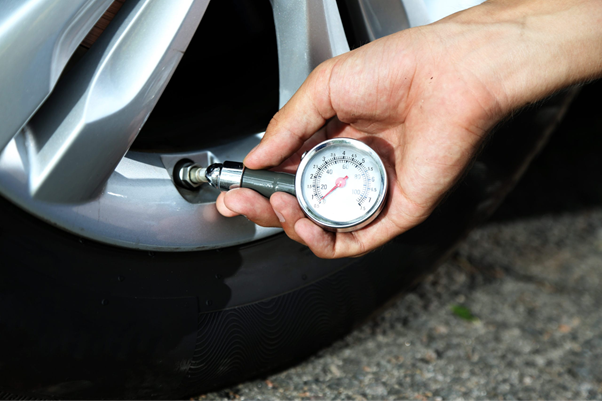How to Put Air in Tires And How to Check Tire Pressure

Ensuring that your vehicle's tires are properly inflated is crucial for both safety and performance. In this guide, walk through the steps of adding air to your tires and checking their pressure to help you maintain optimal tire health.
How to Put Air in Tires
Before you start, make sure you have the following:
- An air compressor or portable air pump
- An air pressure gauge
- Coins (if using a coin-operated air pump)
- Your vehicle's recommended tire pressure (found in the driver's side door jamb or owner's manual)
You can add air to your tires using an air compressor, a portable air pump, or a gas station with an air pump. Some gas stations offer free air service, while others require payment.
Position your vehicle close enough to the air pump so that the compressor hose can reach all underinflated tires.
To add air to your tires:
- Refer to your vehicle's recommended tire pressure (usually around 30-35 PSI) as a guide. Do not use the pressure value printed on the tire sidewall; it indicates the maximum cold pressure.
- Attach the air dispenser to the tire's valve stem and listen for the hissing sound as air enters the tire. The filling time depends on the initial air level.
- Detach the air hose and use a tire pressure gauge to check the pressure accurately. Gas stations may have built-in pressure gauges, but it's wise to double-check with a dedicated gauge.
- Repeat these steps for all underinflated tires until you reach the recommended pressure.
If you accidentally overinflate a tire, you can release excess pressure using the valve stem. Gently press the valve's pin to let out some air while periodically checking the pressure to avoid deflating the tire too much.
Always put back the valve cap on each tire to prevent dust and debris from entering.
How to Check Air Pressure
You'll need an air pressure gauge (either pencil-type or dial-type) for this task. These gauges can be found at auto parts stores or gas stations.
To properly check your tires’ pressure, do the following steps:
- Remove the valve cap from the tire and set it aside in a safe place.
- Press the open end of the air pressure gauge firmly onto the tire's valve stem for a few seconds to allow the instrument to read the pressure. Repeat this process for all of your vehicle's tires, including the spare.
To obtain accurate readings, check tire pressure when the tires are "cold." This means your car should be parked for at least three hours or driven for less than a mile at a moderate speed. Checking pressure when tires are hot from driving may yield less accurate results.
How Often Should You Check Tire Pressure?
Regularly monitoring your tire pressure is essential for safe and efficient driving. Here's a guideline to follow:
- Check your tire pressure at least once a month and before embarking on long journeys to prevent tire-related issues.
- During colder months, check tire pressure every two weeks as temperatures can cause pressure to drop.
Many modern vehicles are equipped with a Tire Pressure Monitoring System (TPMS) that alerts you to low tire pressure through a dashboard warning light. While TPMS is a valuable feature, conducting routine manual inspections remains crucial to maintaining proper tire pressure.
By following these steps and maintaining the correct tire pressure, you'll ensure a smooth and safe driving experience while prolonging the lifespan of your tires.